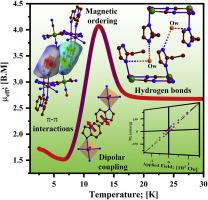Coexistence of two magnetic sublattices in 2D transition metal nitroprussides, T(L)2[Fe(CN)5NO] with T = Mn, Co, Ni; L = 2-ethylimidazole, Imidazo[1,2-a]pyridine
IF 3.5
3区 化学
Q2 CHEMISTRY, INORGANIC & NUCLEAR
引用次数: 0
Abstract
Transition metal nitroprussides form an interesting family of coordination polymers with 3D and 2D structural modifications. The 2D series has a Hofmann-like structure and can be formed from a large set of organic pillar molecules (L). This contribution reveals the coexistence of antiferromagnetic order within the inorganic layer T[Fe(CN)5NO] of the titled 2D solids, and a weak ferromagnetic-like interaction between the paramagnetic metal centers (T) from adjacent layers, T-(L)2-T. The latter interaction is possible through the π-π stacking and hydrogen bonding between pillar (L) molecules. SQUID magnetic data recorded for the titled solids are consistent with such a model of coexistence of two magnetic sublattices. IR and Raman spectra, as well as structural studies from powder XRD patterns, complemented the information derived from the magnetic measurements. The metal (T) polarizing power determines the charge subtraction from the molecular ring, favoring a stronger dipole-dipole coupling and more significantly π-π stacking. From the experimental data obtained, the regularities regarding the roles of both metal and pillars, as well as solid crystal structures, were rationalized.

二维过渡金属硝普苷T(L)2[Fe(CN)5NO]与T = Mn, Co, Ni共存的两个磁性亚晶格L = 2-乙基咪唑,咪唑[1,2-a]吡啶
过渡金属硝普苷形成了一个有趣的配位聚合物家族,具有3D和2D结构修饰。2D系列具有Hofmann-like结构,可以由大量有机柱分子(L)组成。这一贡献揭示了在二维固体的无机层T[Fe(CN)5NO]内存在反铁磁有序,以及相邻层T-(L)2-T之间的顺磁性金属中心(T)之间存在弱铁磁相互作用。后一种相互作用是通过柱(L)分子之间的π-π堆叠和氢键来实现的。标题固体的SQUID磁数据记录与这种两个磁亚晶格共存的模型是一致的。红外光谱和拉曼光谱,以及粉末XRD图谱的结构研究,补充了磁测量得出的信息。金属(T)极化功率决定了分子环的电荷减量,有利于更强的偶极子-偶极子耦合和更显著的π-π堆积。从得到的实验数据中,理顺了金属和柱的作用规律,以及固体晶体结构。
本文章由计算机程序翻译,如有差异,请以英文原文为准。
求助全文
约1分钟内获得全文
求助全文
来源期刊

Journal of Solid State Chemistry
化学-无机化学与核化学
CiteScore
6.00
自引率
9.10%
发文量
848
审稿时长
25 days
期刊介绍:
Covering major developments in the field of solid state chemistry and related areas such as ceramics and amorphous materials, the Journal of Solid State Chemistry features studies of chemical, structural, thermodynamic, electronic, magnetic, and optical properties and processes in solids.
 求助内容:
求助内容: 应助结果提醒方式:
应助结果提醒方式:


